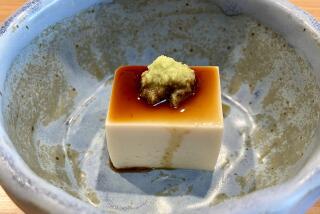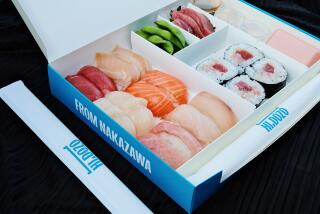Poisonous Fugu : Deadly Fish Still Delights Japan Diners
- Share via
SHIMONOSEKI, Japan — Flopping listlessly in a blue plastic carton on the concrete floor of an auction house in this active seaport, showing the ugly gray-green mottles of its dorsal skin, is $100 worth of fish.
On tarpaulins placed around a dank warehouse, similar cartons hold hundreds of its fellows, some showing their white bellies, others inflated in panic to the size of basketballs. Hideo Ono, president of the local fisherman’s cooperative and undisputed ruler of this bustling compound, holds a thoroughly superfluous megaphone to his face to bark orders in a foghorn voice.
At 3:20 a.m. a bell rings and the daily auction begins of Japan’s paramount culinary delicacy: the globefish or blowfish, or, in Japanese, fugu .
Discriminating Palate
For centuries fugu (pronounced foo-goo) has held Japanese diners in thrall. Its taste subtle to the vanishing point for many Westerners, it is considered indescribably delicious by the discriminating Japanese palate.
But even many Japanese acknowledge that there is one peculiar aspect of fugu that helps place it at the pinnacle of this country’s cuisine: The fish is lethally poisonous, concentrating a deadly tetrodotoxin poison--as much as 25 times more lethal than curare--in the tissues of some of its internal organs and portions of its skin. A diner places his or her life in the hands of chefs licensed to prepare only the nonpoisonous white fillet meat.
This contributes strongly to the captivation of the public. Reputedly, the emperor is forbidden to eat fugu. The 17th-Century poet Basho sang of its flavor and danger. And every diner has heard how fugu poisoning characteristically begins with numbness in the extremities and progresses to a generalized nervous paralysis even as the victim’s mind continues functioning to take in the seriousness of his or her condition.
Licensed Chefs
In the past, before the government imposed rigorous training and licensing standards on fugu chefs, hundreds of diners died each year from even the merest taste of fugu liver, ovaries, or skin.
Today, fugu meals prepared at any of Japan’s hundreds of specialized restaurants are among the most expensive in the country.
A full dinner of several courses, including sashimi-- slices of raw fish, to be eaten with a soy sauce and green radish dip-- fugu stew, miso soup with fugu chunks and a ceramic tumbler of heated sake with two grilled fugu fins floating within, will run up to $400 a person.
Appropriately, some of these restaurants reflect the highest attainments of the Japanese nouvelle cuisine style of presentation, as fugu sashimi is laid before the diner in intricate patterns amid carefully arranged appetizers and courses.
In living form, the fugu gives little hint of the glories of its cuisine, although in Shimonoseki, where about 90% of Japan’s fugu is landed and sold, there is no debating its attributes.
A fleet of 200 trawlers returning from two- to three-week voyages delivers its catch here; last year’s landings at Haedomari market totaled 3,126 tons worth $90 million. To illustrate the exceptional value of fugu , consider that the fish accounted for 52% of the seaport’s total fish landings but 80% of the catch’s total market value.
“ Fugu is the king of the fish,” proclaimed Ono, of the fishermen’s cooperative, as scores of workers manhandle the unlikely monarch into cases before the auction, sorting by size and species.
Like almost every other feature of the fugu trade, the auction process is unique. It begins as auctioneer Hisashi Matsumora slips a black fabric sheath over his right forearm and hand; as he marches down the rows of blue cases, buyers from distributors and restaurants slip their hands inside the sheath, communicating in intricate handshakes their bids for each lot.
Occasionally this covert system produces a tie. Matsumora points at each of the two bidders, and as he marches on, they resolve the tie with a conclusive round of the children’s game of rock-scissors-paper.
Deadlocked Bids
Later, the auctioneer is hard-pressed to explain why the co-op does not extract higher bids from the deadlocked buyers, increasing its profit. Fugu is unique, he says, so the auction method is unique.
Japan’s sometimes incautious relationship with fugu goes back at least as far as medieval times. Fossilized remains of the fugu’s distinctive parrot beak have been found at archeological digs throughout the country; some are blackened, indicating they were cooked.
In Japan’s traditional haiku and senryu poetry, fugu seems to occupy a pride of place that Western bards reserve for nothing less intoxicating than wine. One haiku by the master of the form, Basho, goes: “I enjoyed fugu and soup yesterday.
Luckily, nothing has happened.”
Only One Remedy
Books on preparing fugu have been dated as early as 1763, when the fish were sometimes known as “river pigs,” said Osami Tabeta, associate professor of aquaculture and biology at Shimonoseki University of Fisheries. These books identify almost as many species of fugu as are known today, recommend the best fishing sites and recognize that the only remedy for fugu poisoning is to force the victim to vomit immediately after ingesting a tainted bite.
Centuries of experience have not produced a better cure. In 1986, the last year for which complete figures are available, there were five fugu -related deaths in Japan and close to 30 nonfatal poisonings. Tabeta said the death and poisoning rates--which, he hastened to add, reflect fugu preparation by amateur chefs at home--tend to fluctuate in cycles over periods of several years.
“Every time there is a (well-publicized) death, people get more cautious,” he said. “Then they forget and the rate goes up.”
Kabuki Actor’s Death
The industry’s worst modern crisis of confidence came undoubtedly in 1975, with the death that January of the celebrated Kabuki actor Mitsugoro Bando after a restaurant feast in Kyoto. Bando had insisted on dining on fugu liver--some reports speculated that he thought he was getting the liver of a less-poisonous species--and ate not only his own portion but those of his four guests. That night he perished.
Fugu sales and prices immediately plummeted by 75%, prompting an alarmed Shimonoseki to undertake an extensive public-relations campaign to restore its reputation. In any event, deaths dropped to 15 in 1976 from 36 in 1974.
After a trial, the cook was given an eight-year suspended sentence for professional negligence. The restaurant later made a 26-million-yen settlement, or about $208,000 at today’s exchange rate, to the actor’s family.
$14.50 a Pound
Today, fugu is more popular than ever before, fishery officials say. Landings at Haedomari market have grown to more than 3,000 tons a year from about 800 tons in 1975. In the same period, the price per kilogram has risen to an average 4,000 yen, or about $14.50 a pound, from 1,300 yen. The choicest fugu , 3-year-old tora, or tiger, fugu weighing one kilogram each, fetched closer to $45 a pound at the Haedomari auction.
In a development that would be familiar to American salmon or lobster fishermen, there is now great concern that the public’s enthusiasm has led to overfishing. The catch of one of two great schools of fugu --the one found in Japan’s Inland Sea--has been dropping sharply. Accordingly, several seacoast municipalities and the Japanese government have combined resources to undertake a program of cultivating the tora fugu.
The program has begun to yield hundreds of tons of fish a year, but as Tabeta acknowledges, there are real obstacles to its paying for itself. One is the fugu’s predilection for cannibalism--it is immune to its own poison--forcing aquaculturists to spend great time and money separating the fish from each other. Even more bothersome is a detectable difference in quality between wild and cultured fugu.
Cultured Fugu
Ono himself allows as how the cultured fugu’s meat is watery compared to that of natural fugu, producing a texture lacking the rubbery consistency cherished by sashimi eaters. At the Shimonoseki auction, cultured fugu draws only half the price of wild fish and is placed up for sale last, after even the lowliest natural species, including those that are bought only to be made into the ubiquitous stuffed lanterns and souvenir trinkets for sale throughout this city.
The process of refining the fish down to its safely edible portions and then preparing it for the table helps drive the price of a fugu meal to its stratospheric levels. In tables like assembly lines in a building across from the Haedomari market, legions of licensed fugu butchers go to work as soon as the first auctioned fish are trundled across the parking lot at 3:30 a.m.
They lop off the snouts, strip away the outer skin and peel off the edible inner skin from the mottled hide. Eviscerating the fish, they drop the poisonous liver into bins headed for incinerators, the only approved way of disposing of the organ.
Air-Freighted Live
Finally, they extract the plump fillets, which are shipped to restaurants along with the back meat, still attached to spinal bones, that will go into fugu stew. A similar process takes place at many restaurants that receive their fugu air-freighted live on flights leaving Shimonoseki, on the extreme southwestern tip of Honshu, Japan’s largest island, at 9 a.m. every day.
At the inns and restaurants, the fugu fillets are turned over to experienced chefs like Kaneharu Koshima of the Nakashima Inn in Shimonoseki.
A serious and businesslike 65, Koshima said he has been preparing fugu since he was 11, when he was apprenticed to a fugu master in his native city of Nagoya. His own parents ran a restaurant, but as the second son he stood to inherit nothing.
“I needed a special skill,” he said.
Koshima’s tools and techniques are unique even within the peculiarly specialized world of Japanese cuisine. He unfurls a roll of moistened cotton to produce three plump cylindrical white fillets. Withdrawing a long sashimi knife from its wooden sheath, he contrasts its straight edge with the curved edge of a conventional sashimi knife. His cutting surface is a foot-thick slab of gingko wood, chosen because it has no smell of its own to impart to the delicate fugu meat.
Designer Slices
Slicing the fillet in millimeter-thick leaves and then feathering each piece thinner again, he lays them out around the rim of a patterned ceramic plate, working gradually in to the center in a pattern of translucent slices designed to evoke the tail of a peacock. The delicacy of the slices makes a virtue of the fugu ‘s toughness, for a slice the thickness of any other sashimi would be impossible to chew, he said.
Working next to Koshima, a younger chef, Katsuhisa Endo, arranges his fillets into the design of a chrysanthemum. Already prepared is another plate depicting a feathered crane, and one spectacular seashore scene using slices of fugu sashimi for the surface of the ocean, fine strips of white skin for the breakers upon the shore and a mound of green herbs for mountains rising from the beach.
Such artistry is pricey. Even the smaller dishes, each serving as an appetizer for two, will cost $160 per person, said Shohei Maeda, the inn’s owner.
More to Read
Eat your way across L.A.
Get our weekly Tasting Notes newsletter for reviews, news and more.
You may occasionally receive promotional content from the Los Angeles Times.










